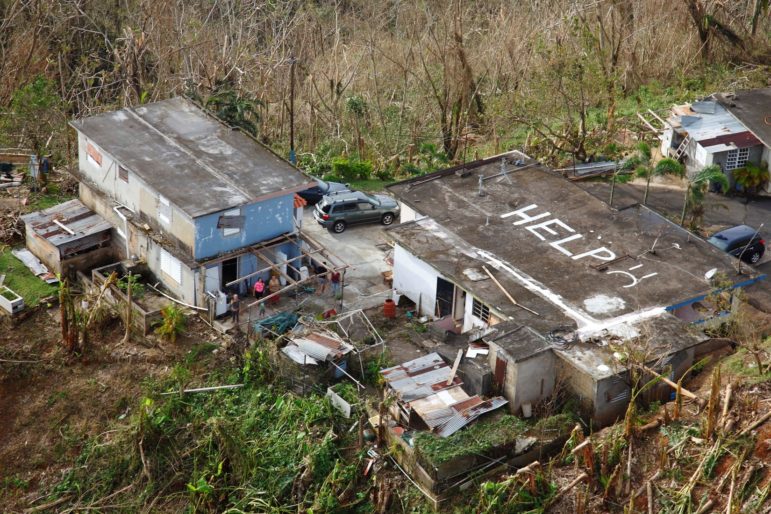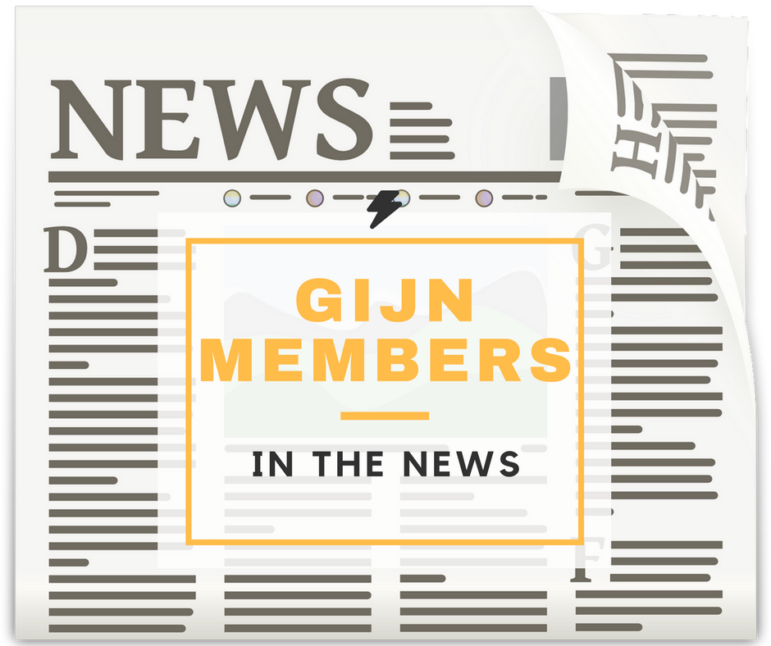

Despite Losses, Puerto Rican Journalists Keep Reporting After Hurricane
International and Puerto Rican media have set up shop in the Puerto Rico Convention Center, creating a de facto newsroom in the same building where officials give press conferences and citizens look for resources.
Aside from Internet and cell service, it is the place to find all government sources who will provide updates on efforts to help the 95 percent of Puerto Ricans without power, as well as the thousands without food, water, fuel and medical help.

The team from GIJN’s member in Puerto Rico, the Centro de Periodismo Investigativo, reports from the battered island’s Convention Center. (Credit: Carla Minet)
Carla Minet, journalist and executive director of Puerto Rico’s Center for Investigative Journalism (CPI for its acronym in Spanish), sits at one of the tables with her news team.
On Monday, Sept. 25, five days after Hurricane María hit the island’s southern coast, they all were finally able to gather in San Juan to assess what happened and figure out how to report in the new scenario.
The storm hampered, and in most places totally debilitated, the ability to communicate. As of Sept. 29, 89.3 percent of cell sites in Puerto Rico were still out of service, according to the Federal Communications Commission (FCC).
“We all were thinking alike and we all came to San Juan and that’s where all the phones started connecting, and then we said ‘okay, let’s meet,’” Minet said in conversation with the Knight Center.
Their office didn’t have power so they borrowed an office to work out of as they went to the streets to report. Like many other journalists in the area, they eventually made their way to the convention center to report, conduct interviews and publish on the storm’s aftermath. They work with hotspots, computers, phones and limited resources.
A team of five reporters is moving throughout the island when they are not in San Juan –to the center, the north coast and other metropolitan areas.
Once they leave the convention building, communication becomes more difficult.
“Outside of San Juan we have no phone connection, no messaging, no WhatsApp, no nothing,” Minet explained.
Though the journalists are physically fine, Minet said some of them have family who lost homes or are stranded without water or gas.

Hurricane Maria makes landfall in Puerto Rico (Credit: By NOAA [Public domain], via Wikimedia Commons).
“We are dealing with that reality,” she explained. “We are trying to do our job and then help our families.”
Less than two weeks after Hurricane Irma passed over the northern coast of Puerto Rico and left 1 million residents without power, María landed on the island on Wednesday, Sept. 20, with maximum sustained winds of 155 mph.
In preparation, a skeleton crew in the San Juan newsrooms of GFR Media stocked enough food and fuel to operate for 36 to 48 hours. It would prove to be a good plan for the company, which owns newspaper-of-record El Nuevo Día, as well as Primera Hora and Índice. Replacements weren’t able to relieve them until Thursday afternoon.
As the crew prepared in San Juan, the paper sent more than 20 reporters and photographers to different zones across the island with enough food and gas for two days. They were embedded with emergency officials. Luis Alberto Ferre Rangel, general director of GFR Media, explained to the Knight Center it was a protocol the paper had followed in the past.
As expected, the newsroom lost communication with the journalists as soon as the storm hit.
“We saw each one of them sign off, pretty much, until the very last one when everything was quiet and there was total silence, total radio silence,” Ferré Rangel said. “That’s when the winds were the highest and strongest in the area and we knew that they were now on their own and left to their own devices.”
While the storm passed over the island, the newsroom reported as best it could using AM radio dispatches. Despite having three internet providers, “in the end, all three of them failed,” Ferré Rangel recalled.
Rosalina Marrero reported for GFR Media from southwestern Puerto Rico in Mayagüez.
“I went through the hurricane in one of the shelters authorized by the government, there as a witness of how the families, individuals … elderly people, arrived with their few belongings, many with their pets, looking for safety, but at the same time with the sadness of having left their homes without the guarantee of returning to find them again,” Marrero told the Knight Center.
“It’s a kind of reporting in which it becomes impossible not to break, because for the moment one becomes the first aid for someone who needs to leave their home, some food, to be rescued,” she added. “It also becomes a challenge to reach the places with the greatest needs.”
Marrero reiterated that just like other citizens, journalists were affected by a lack of gasoline and absence of telephone and internet, complicating communications.

Officials conduct search and rescue in mountains of Puerto Rico after Hurricane Maria (Credit: U.S. Customs and Border Protection, via Wikimedia Commons).
The reporters across the island eventually found pockets of service where they could re-establish communication with the newsroom. But, in order to eventually make it back to San Juan, some had to be evacuated from emergency shelters that were compromised, according to Ferré Rangel. Four journalists had to be airlifted out of the small islands of Vieques and Culebra.
The last journalist to return from the field arrived five days after the hurricane landed and he lost his home in the mountains. Ferré Rangel said at least three staffers lost their properties due to flooding or explosions, which happens when a difference in air pressure inside and outside the house causes windows to burst and leaves the home to the elements.
Eventually, “Everybody started reporting back to base, even the ones that were not on duty, just because as reporters and editors they know they have to come and help,” the director said. “By Thursday afternoon, we had more than 50 percent of the newsroom present.”
They returned to print on Thursday with 30,000 copies, as well as an electronic version available online, all distributed for free. On Friday, they printed 50,000.
“With 100% blackout, no electricity whatsoever in the whole island, the print product, once again, the print product, back to paper, back to the basics, was welcome news for everybody because the only means of information during the first 48 hours after the hurricane was one radio station who had no staffers out there,” Ferré Rangel said.
The paper has been distributed for free since the day following the hurricane. But, when asked, Ferré Rangel admitted it has been tough for the paper financially and they will have to return to charging in coming days.
“We are facing a very difficult situation because we have had no advertising and no circulation revenues,” the director said. “It is putting a lot of pressure on the financials of the company, but we understand that we have to do this.”
For the journalists, the work has been nonstop.
“I think the newsroom, they live for this type of situation and it brings out the best in everybody and it shows you the capacity that we have and the dedication that we have to do something like this,” Ferré Rangel said. “But the challenge now is it’s a very, very long road so we are still in emergency mode and so the reporting is very intense, everybody’s out, but soon it’s going to be moving to more reconstruction and rebuilding kind of reporting.”
Back at the convention center, Damaris Suárez, journalist and president of the Association of Journalists of Puerto Rico (ASPPRO), said the organization is trying to create a list of journalists who experienced personal losses due to the hurricane. They may collect money or set up a GoFundMe account to help them recover.

Omaya Sosa Pascual, co-director of the Puerto Rican Centro de Periodismo Investigativo, discusses a story with a local radio station. (Credit: Carla Minet).
Suárez, who works as a journalist for digital site Noticel, CPI and Radio Isla 1320, told the Knight Center that some outlets experienced physical damage to their buildings. For example, the offices of Noticel, which face the sea, were greatly impacted and the team needed to move to an alternate facility.
She pointed to the lack of access to telephone and internet, particularly outside of the metropolitan area, which means that “a large amount of the country doesn’t have accurate information about what’s happening.”
“The journalists in Puerto Rico we have done the impossible to inform the public despite the serious difficulties with communication and digital infrastructure as a result of the damages brought by Maria,” Suárez said.
This story originally appeared in the Journalism in the Americas blog by the Knight Center for Journalism in the Americas at the University of Texas at Austin.
 Teresa Mioli is online content coordinator at the Knight Center, interested in press freedom, democratization, and investigative journalism in Latin America.
Teresa Mioli is online content coordinator at the Knight Center, interested in press freedom, democratization, and investigative journalism in Latin America.









